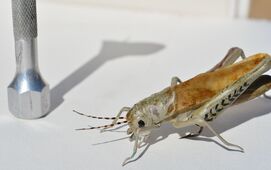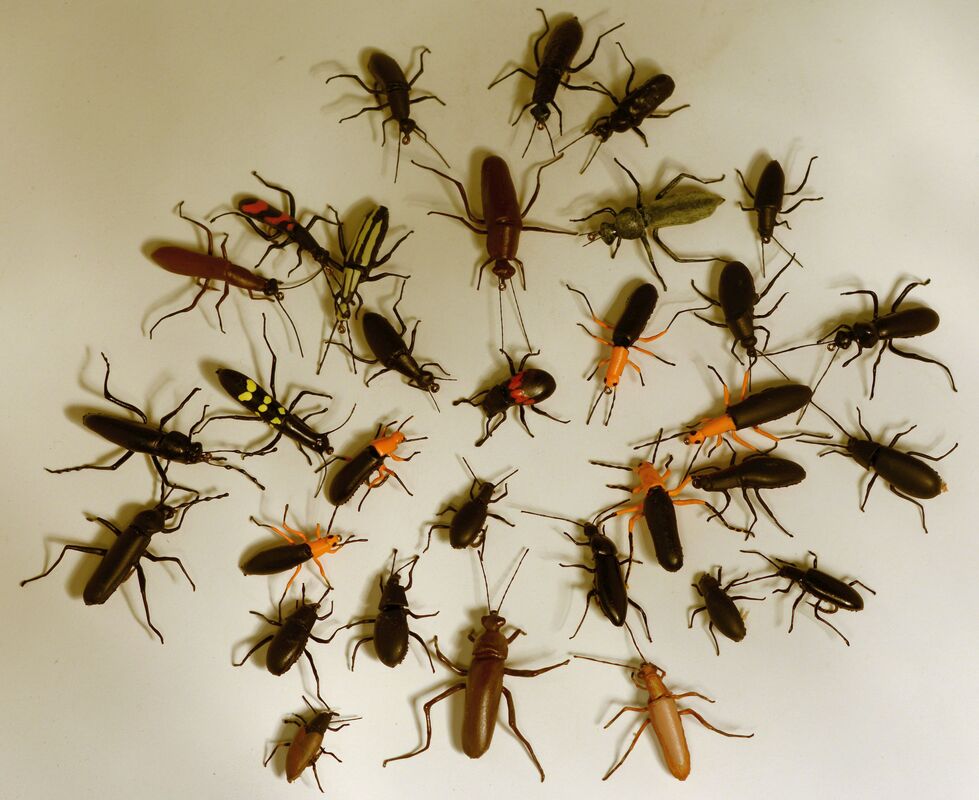How I Got Bitten by the Realistic Bug
Although my tying has virtually been, on my own learning, I have relied on references to guide me. It's funny to realize how little you know a subject or about a certain thing until you start to created in the vice. Take an ordinary housefly. You see them constantly, yet try to tie one. You will surprise yourself at how little you really know if you're trying to make an exact copy. Therefore, I rely heavily on reference books and collecting specimens. Google images is a fantastic reference also. I know it sounds crazy, but there's no substitute for re-creating a wing, or a leg if you have the real ones taped down to a nice flat surface so you can study them up close. Many of the book references are way over my head. And they refer to everything in technical terms I still don't know. There are a few things I've picked up though, just by looking that have been extremely helpful. I found out that I really didn't have to understand or speak Latin.
My choice of realistic fly tying is or was not a very popular activity when I started 30 years ago. No one in my area was doing it. Not even on a national level, as the interest was rare. Everything in tying materials was feathers and furs. If you don't use this, you are on your own. No shops or material sources had yet recognized that realistic tying was soon to be in vogue. The very first time I even saw realistic flies, I was captivated by their appearance. I remember, they were tied by Bill Blades. He was experimenting with unusual materials and methods in the late 30s and early 40s. He was the first to use almost anything in materials as long as it achieved his intent. He was the first I knew of who painted, and carved, molded or even sculptured. And he was bold enough to show and share it. The first time I saw Dan Bailey's veined wing material on his Stonefly adult that Jack Herter sold in sheets for cutting up, I was hooked. I used up a whole months pay for my paper route to buy five packs of this material. One thing this whole experience taught me is if you want to do realistic patterns are going to have to do it on your own, and create your own materials and techniques. Even today when I see or read what materials other tyers are using to create their flies, I am amazed by what they use. There's still creating on their own, whatever technique or material that suits their needs. I know this also may sound crazy, but when I tie at shows or give demonstrations, I'm not able to visit other tyers and to sit and watch them tie. I'm busy tying likewise as they do the same. At that time most of the realistic tyers were on the East Coast, or Europe and England. I was too far away and too embarrassed to call or write them. Also tying, in my opinion, is something you have to observe. I can talk or write until I'm blue in the face on how I do my Hopper wings that I can show you in about five minutes and you won't fail when you try it yourself.
It was not until my work was published in 1988 in a book named "the Art of the Trout Fly", that I realize there were many other tyers also working on realistic patterns. Since that time I have had the pleasure to work with, meet, but not watch some of the best. This phase of my own tying is the most exciting and rewarding. I'm still working on my own, and experimenting with anything and everything. I would also like to think I have had a small influence on the vast assortment of synthetic materials you find in the fly shops today. Materials that have had a profound impact on the fly pattern assortment you see on the market today. If you are a Tyer, and if you are interested in the creative side of fly tying, particularly with respect to realistic flies, you can't do it without some study and references. You will need some books and some samples to help you. Find any resources that will help you study your subject. The Audubon book series, or Google insects of North America. Remember that your goal is to re-create your fly as realistically as possible. Happy tying...
Although my tying has virtually been, on my own learning, I have relied on references to guide me. It's funny to realize how little you know a subject or about a certain thing until you start to created in the vice. Take an ordinary housefly. You see them constantly, yet try to tie one. You will surprise yourself at how little you really know if you're trying to make an exact copy. Therefore, I rely heavily on reference books and collecting specimens. Google images is a fantastic reference also. I know it sounds crazy, but there's no substitute for re-creating a wing, or a leg if you have the real ones taped down to a nice flat surface so you can study them up close. Many of the book references are way over my head. And they refer to everything in technical terms I still don't know. There are a few things I've picked up though, just by looking that have been extremely helpful. I found out that I really didn't have to understand or speak Latin.
My choice of realistic fly tying is or was not a very popular activity when I started 30 years ago. No one in my area was doing it. Not even on a national level, as the interest was rare. Everything in tying materials was feathers and furs. If you don't use this, you are on your own. No shops or material sources had yet recognized that realistic tying was soon to be in vogue. The very first time I even saw realistic flies, I was captivated by their appearance. I remember, they were tied by Bill Blades. He was experimenting with unusual materials and methods in the late 30s and early 40s. He was the first to use almost anything in materials as long as it achieved his intent. He was the first I knew of who painted, and carved, molded or even sculptured. And he was bold enough to show and share it. The first time I saw Dan Bailey's veined wing material on his Stonefly adult that Jack Herter sold in sheets for cutting up, I was hooked. I used up a whole months pay for my paper route to buy five packs of this material. One thing this whole experience taught me is if you want to do realistic patterns are going to have to do it on your own, and create your own materials and techniques. Even today when I see or read what materials other tyers are using to create their flies, I am amazed by what they use. There's still creating on their own, whatever technique or material that suits their needs. I know this also may sound crazy, but when I tie at shows or give demonstrations, I'm not able to visit other tyers and to sit and watch them tie. I'm busy tying likewise as they do the same. At that time most of the realistic tyers were on the East Coast, or Europe and England. I was too far away and too embarrassed to call or write them. Also tying, in my opinion, is something you have to observe. I can talk or write until I'm blue in the face on how I do my Hopper wings that I can show you in about five minutes and you won't fail when you try it yourself.
It was not until my work was published in 1988 in a book named "the Art of the Trout Fly", that I realize there were many other tyers also working on realistic patterns. Since that time I have had the pleasure to work with, meet, but not watch some of the best. This phase of my own tying is the most exciting and rewarding. I'm still working on my own, and experimenting with anything and everything. I would also like to think I have had a small influence on the vast assortment of synthetic materials you find in the fly shops today. Materials that have had a profound impact on the fly pattern assortment you see on the market today. If you are a Tyer, and if you are interested in the creative side of fly tying, particularly with respect to realistic flies, you can't do it without some study and references. You will need some books and some samples to help you. Find any resources that will help you study your subject. The Audubon book series, or Google insects of North America. Remember that your goal is to re-create your fly as realistically as possible. Happy tying...


